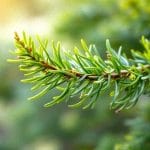Takeaways
- Buckthorn berries pack a nutritional punch with high vitamin C content
- The plant offers potential benefits for digestive and heart health
- Buckthorn oil may improve skin conditions when applied topically
- Some species can become invasive, requiring responsible use and harvesting
- More research is needed to fully understand buckthorn’s effects on health
- Consult a healthcare provider before using buckthorn supplements
What is Buckthorn?
Buckthorn is a plant that belongs to the genus Rhamnus.[1] This plant can grow as a shrub or a small tree, and it is found in many areas around the world.[2] It is known by several names, including common buckthorn and sea buckthorn.[3]
Buckthorn plants have simple leaves and branches with thorns.[4] The bark of the plant is typically dark and rough.[5] Buckthorn also produces small, round berries that change from green to black or dark purple as they ripen.[6]
There are multiple species of buckthorn located across the globe. Common buckthorn (Rhamnus cathartica) is found in Europe and North America.[7] Sea buckthorn (Hippophae rhamnoides) is common in Asia and Europe, and Alder buckthorn (Rhamnus frangula) grows throughout Europe and western Asia.[8]
Historical Uses of Buckthorn
Traditional Medicine
Buckthorn has been used in folk medicine for a long time. Various cultures have used it to try and treat different health issues.[9] People have valued the plant because of its perceived ability to help with healing.
Buckthorn was often used as a laxative by traditional healers.[10] They believed it could help cleanse the body and aid digestion. Some traditions also used buckthorn for treating skin problems and wounds.
Ancient Practices
Ancient medical systems included buckthorn in their treatments. Physicians in Greece and Rome mentioned it in their writings and prescribed it for digestive problems, among other health concerns.[11]
During the Middle Ages, European herbalists also utilized buckthorn. They included it in remedies for various illnesses, and it appeared in early medical books and pharmacopeias of that time.[12]
Nutritional Profile
Buckthorn berries are packed with various nutrients, offering a good source of vitamins and minerals.[13] This nutritional content makes them a popular choice for those interested in health-conscious eating.
| Nutrient | Amount per 100g |
|---|---|
| Vitamin C | 400-600 mg |
| Vitamin E | 5-10 mg |
| Vitamin A | 60-100 IU |
| Omega-3 fatty acids | 0.5-1 g |
| Omega-6 fatty acids | 2-3 g |
| Protein | 2-3 g |
| Fiber | 2-3 g |
Buckthorn berries are notably high in vitamin C compared to other berries.[14] They contain more vitamin C than oranges and also offer more vitamin E than many typical fruits.[15]
Health Benefits
Digestive Health
Buckthorn may help improve digestive function.[16] Its berries and bark have compounds that act as natural laxatives.[17] These compounds can help stimulate bowel movements and ease constipation.
Some people use buckthorn to help with regular digestion. However, using it too much may cause stomach problems.[18] It’s important to use buckthorn for digestive health according to recommended amounts.
Immune Support
The significant amount of vitamin C in buckthorn might strengthen the immune system.[19] Vitamin C helps the body produce white blood cells, which are needed to defend against infections and diseases.[20]
Buckthorn also contains antioxidants, which help protect cells from damage.[21] A strong immune system relies on healthy cells to work correctly.
Skin Health
Buckthorn oil shows potential for supporting healthy skin.[22] It is applied directly to the skin to help treat conditions like dryness, eczema, and to assist in wound healing.[23]
The fatty acids in buckthorn oil can nourish the skin. They can improve skin’s elasticity and moisture.[24] Some studies suggest that buckthorn oil might reduce the signs of aging.[25]
Heart Health
Research suggests that buckthorn could be good for heart health.[26] The berries contain flavonoids and other plant compounds that may help lower cholesterol levels.[27]
Some studies indicate that buckthorn can help reduce blood pressure and improve blood sugar control.[28] These effects could lower the risk of heart disease. However, more research is necessary to confirm these benefits.
Forms and Preparations
Buckthorn Berries
Fresh buckthorn berries have a tart taste.[29] They can be eaten raw or used in various recipes. Dried berries are suitable for making teas and herbal mixtures.
To safely eat buckthorn berries, make sure they are fully ripe.[30] Unripe berries can lead to digestive problems.[31] Always wash fresh berries well before consuming them.
Buckthorn Oil
Buckthorn oil is extracted from the seeds and pulp of the berries.[32] Cold-pressing is a method used to preserve the oil’s nutrients.[33] This process results in an oil with a rich, orange color.
Buckthorn oil is used in cooking, skincare, and more.[34] It can add nutritional value to foods and salad dressings. For skin, it can be applied directly or mixed into lotions.
Supplements
Buckthorn supplements are available in several forms, including:
- Capsules
- Tablets
- Liquid extracts
- Powders
Choose supplements from trustworthy brands. Look for products that have been tested by outside labs, as this helps to ensure good quality and purity.[35] Always follow the instructions for dosage on the label.
Dosage and Administration
General recommendations for buckthorn dosage can vary. The right amount to use depends on things like the specific form of buckthorn being used and what it’s being used for.[36]
Factors like age, overall health, and any other medications you may be taking can impact the correct dosage. It’s best to start with a low dose and gradually increase it if needed.
| Form | Recommended Dosage |
|---|---|
| Fresh berries | 20-30 berries daily |
| Dried berries | 5-10 grams daily |
| Oil | 5-10 ml daily |
| Capsules | As directed on label |
It is recommended to talk to a healthcare provider before using buckthorn.[37] They can help determine the appropriate dose for your needs. This is particularly important if you have any existing health conditions.
Potential Side Effects and Risks
Common Side Effects
Buckthorn may cause some mild side effects in certain individuals. These are often related to its laxative effects. Potential reactions include:
- Stomach cramps
- Diarrhea
- Nausea
Most side effects tend to lessen as the body gets used to the buckthorn.[38] If you experience discomfort, try reducing the amount you are using.
Contraindications
Using buckthorn may be unsafe with certain health conditions. Avoid buckthorn if you have:
- Intestinal blockages
- Crohn’s disease
- Ulcerative colitis
- Appendicitis
Buckthorn can interact with certain medications.[39] It may change how the body absorbs these drugs, so it’s important to inform your doctor about all the supplements you’re taking.
Pregnancy and Breastfeeding
Women who are pregnant or breastfeeding should avoid using buckthorn.[40] There is not enough research available to prove its safety during these times.
Some compounds in buckthorn could affect the uterus, potentially causing harm during pregnancy. Breastfeeding mothers should also take precautions and avoid buckthorn.
Harvesting and Preparation
Identifying Buckthorn
Knowing how to identify buckthorn can help ensure that it is harvested safely. Look for these characteristics:
- Oval-shaped leaves with serrated edges
- Dark bark with light-colored lenticels
- Clusters of small flowers in spring
- Berries that turn dark purple or black when ripe
Always double-check the plant’s identity before harvesting.[41] If you are uncertain, consult an expert or a field guide for confirmation.
Harvesting Techniques
Buckthorn berries should be harvested in late summer or fall. This is when they are ripe and have the most nutrients.[42]
Use clean, sharp scissors or pruners to cut the clusters of berries. Be careful not to damage the plant during harvesting. Only take what you need, leaving enough for wildlife and the plant to reproduce.
Home Preparation Methods
To prepare buckthorn at home, follow these steps:
- Wash the berries thoroughly in cool water
- Remove any stems or leaves
- Pat the berries dry with a clean cloth
- Use immediately or freeze for later use
To make buckthorn juice, blend fresh berries and strain the mixture. For making preserves, cook the berries with sugar and lemon juice until it thickens.
Environmental Impact
Invasive Species Concerns
Some buckthorn species can become invasive outside of their native areas.[43] Common buckthorn, for example, is known to cause problems in North American ecosystems.
Invasive buckthorn can outcompete native plants.[44] It can form thick clusters that change habitats. This affects the local wildlife and the diversity of plants.
Conservation Efforts
Many areas have programs in place to control invasive buckthorn.[45] These programs focus on removing the buckthorn plants and replanting native species.
Sustainable harvesting methods help to protect buckthorn populations.[46] Only harvest from areas where it is plentiful and avoid taking berries from rare or threatened species.
Research and Future Prospects
Scientists are still studying the potential health benefits of buckthorn.[47] Ongoing research is focusing on its effects on different health conditions.
Some promising areas of study include the effect of buckthorn on cancer cells. Researchers are also looking into its potential in the treatment of metabolic disorders.[48]
Some challenges in buckthorn research include making sure the extracts are consistent.[49] Different species of buckthorn and different preparation methods can lead to different results.
FAQ
What are the main differences between sea buckthorn and common buckthorn?
Can buckthorn help with weight loss?
Is it safe to consume buckthorn during pregnancy?
How long does it take to see benefits from taking buckthorn supplements?
Are there any drug interactions with buckthorn?
Can buckthorn oil be used directly on the skin?
What’s the best way to incorporate buckthorn into my diet?
How does buckthorn compare to other superfoods?
This is a basic taxonomic classification of buckthorn. Rhamnus is the genus that encompasses various species of buckthorn.
Buckthorn species have varied growth forms. Their global distribution is also well-documented, though some species are invasive outside of their native ranges.
While both are ‘buckthorns’ they are from different genuses. Common buckthorn is Rhamnus cathartica and Sea buckthorn is Hippophae rhamnoides.
While many Buckthorns have thorns, such as Rhamnus cathartica, not all do. The presence and type of thorns can vary between species.
The appearance of bark varies, but generally it is dark gray or brown and becomes rough with age. Some species can have a more smooth texture when young.
While many species of buckthorn have berries that ripen to a dark color, not all go from green to dark purple. Sea buckthorn berries are a distinct orange color.
Rhamnus cathartica was introduced to North America, where it is now considered an invasive species in many regions.
These are the general geographical distribution areas of the respective species. Sea buckthorn is not found in the Americas natively, but can be found naturalized in places.
Historical records and ethnobotanical studies indicate a long history of buckthorn use in traditional medicine. This includes both bark and fruit, though preparation methods vary.
Buckthorn bark and berries contain compounds that act as natural laxatives, which explains its traditional use for this purpose. However, overuse can cause digestive discomfort.
Historical records of Greek and Roman medicine show that buckthorn was used for various health issues, including digestive complaints.
Buckthorn’s medicinal use continued into the Middle Ages, with many herbalists including it in various remedies as documented in period medical texts.
The nutritional content of buckthorn berries varies by species but, in general, they offer a range of beneficial vitamins and minerals. Sea buckthorn is particularly known for high levels of Vitamin C, A, and E.
Sea buckthorn berries (Hippophae rhamnoides) are known for their very high vitamin C content, often exceeding that of many common berries. However, the vitamin C content in other buckthorn species berries is variable. Common buckthorn is not often referenced for its Vitamin C content.
Sea buckthorn berries, specifically, are known for exceptionally high vitamin C levels compared to oranges. Also, while the vitamin E content is more than many other fruits, the levels do vary significantly.
Source: “The Systematics, Reproductive Biology, Biochemistry, and Breeding of Sea Buckthorn—A Review” https://www.ncbi.nlm.nih.gov/pmc/articles/PMC10743242/
The laxative properties in buckthorn may aid digestive function in cases of constipation. However, its use is not always beneficial and should be done with caution.
Anthraquinone glycosides in buckthorn bark and berries are known to stimulate bowel movements which contribute to its laxative effect.
While it can be used to stimulate bowel movements, excessive or improper use can cause digestive distress like diarrhea and cramps. It is not recommended for long-term use.
Vitamin C is known to support immune function by contributing to the production and function of white blood cells. Thus, a good source of it could help to support general immune system function.
Vitamin C is involved in various aspects of the immune system, including the production and function of white blood cells. This is a well documented and basic fact about Vitamin C.
Antioxidants in buckthorn help counteract oxidative stress by neutralizing free radicals. This protection is helpful to prevent various illnesses and general cell damage.
Buckthorn oil has been noted for its potential benefits on skin health due to its high content of fatty acids and bioactive components.
Source: “Plant-Derived Antioxidants: Significance in Skin Health and the Ageing Process” https://www.ncbi.nlm.nih.gov/pmc/articles/PMC8776015/
Some studies suggest that buckthorn oil has properties that may help with these conditions, though results have been varied. More research is needed for definitive conclusions.
Source: “Sea Buckthorn in Plant Based Diets. An Analytical Approach of Sea Buckthorn Fruits Composition: Nutritional Value, Applications, and Health Benefits” https://www.ncbi.nlm.nih.gov/pmc/articles/PMC8431556/
Fatty acids like omega-3, omega-6, and omega-7 found in buckthorn oil are believed to contribute to skin health by improving moisture, elasticity, and overall skin barrier function.
Antioxidants in buckthorn oil can help protect skin from damage and may have anti-aging effects, though studies are limited.
Source: “Plant-Derived Antioxidants: Significance in Skin Health and the Ageing Process” https://www.ncbi.nlm.nih.gov/pmc/articles/PMC8776015/
There’s evidence that compounds in buckthorn may help with cholesterol and blood pressure. More research is needed to confirm these effects.
Flavonoids have been shown to contribute to reducing cholesterol in general, and buckthorn berries contain a significant amount. More studies are needed to confirm the effect.
Early research does suggest some positive effects of buckthorn on blood pressure and sugar control but more conclusive research is necessary to confirm the results and mechanisms.
The berries of buckthorn, including sea buckthorn and common buckthorn, are generally known for their tart taste due to their acidity.
Unripe buckthorn berries may contain compounds that can cause digestive discomfort or upset. Allowing the berries to fully ripen will help to avoid issues.
Unripe berries may contain substances that irritate the digestive tract, leading to stomach problems such as nausea or diarrhea.
The oil content and quality varies depending on whether the extraction is from just the seed or from the entire pulp/seed mix.
Cold pressing keeps heat to a minimum, which can degrade some of the beneficial compounds in the oil.
Buckthorn oil has a strong flavor that makes it suitable in some cooking applications. Its high fatty acid content makes it also used for skincare.
Third party testing helps to verify the ingredients and quantities in the supplement, as well as check for unwanted contaminants.
The appropriate dosage of buckthorn depends greatly on the specific form (berry, oil, supplement), intended use, and individual factors. A health professional should be consulted.
It is important to discuss with a doctor before starting a new supplement like buckthorn, especially for those with pre existing health conditions or who are on other medications.
Some initial mild digestive side effects may decrease with continued use, but caution is advised for potential issues. It is not clear how many people experience this. It is important to stop using it if problems persist.
Due to the potential laxative effects, it can alter the way the body absorbs some medications. It may also effect blood sugar and blood clotting. It is vital to consult a doctor if using medications.
There is not enough research to prove its safety during pregnancy and breastfeeding. It is wise to avoid its use during these times.
Accurate identification is important to avoid accidentally harvesting a potentially dangerous species. Consult with a field guide or expert when unsure.
The berries are typically most nutritious and palatable when they are fully ripe, which is usually in late summer and fall. Specific timing can depend on the exact species and region.
Rhamnus cathartica (Common buckthorn) is known to be invasive in parts of North America.
Invasive buckthorn grows quickly and can shade out native plants, making it difficult for them to thrive.
Many regions with invasive buckthorn implement control and removal programs to manage populations and protect native ecosystems.
Harvesting only from plentiful areas, respecting growth cycles, and avoiding taking too much will help to ensure that buckthorn populations can persist.
Research into buckthorn’s potential medicinal effects is ongoing. Different species and preparations may yield different results. More conclusive research is needed.
Buckthorn’s potential role in cancer treatment and management of metabolic disorders is currently being studied. More conclusive research is necessary.
Variations between species and preparation methods of buckthorn can lead to inconsistent research results. Standardized methods are important.
They belong to different genuses; Hippophae and Rhamnus, respectively.
Sea buckthorn is known for its orange color and nutritional properties. Common buckthorn is noted for its dark berries and invasive potential.
Although buckthorn may contain various nutrients, it is not shown to directly aid weight loss. This is not a widely accepted claim.
Because of a lack of safety data, buckthorn use is not recommended during pregnancy. Consult with a medical professional.
The results vary widely and can be influenced by the health condition, dosage, preparation method, and individual physiology.
Due to compounds in buckthorn having a potential effect on blood clotting and blood sugar levels, there may be interactions with medications related to those things.
Buckthorn can be added to the diet using fresh or dried berries, or the oil can be used in dressings or mixed in foods. Start with small amounts to assess tolerance.
Sea buckthorn is exceptionally high in vitamin C and also contains a variety of other nutrients.



